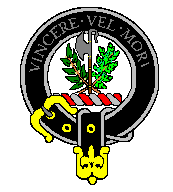The Clan MacLaine
Septs of the Clan MacLaine of Lochbuie

MacGillivray
From "Macgille bhrath", translated as "son of the servant of judgement". The original home of the MacGillivrays was on the Isle of Mull. The main MacGillivray settlement was in Glencannel, north of Lochbuie. Some of the clan moved north to start a branch in Dunmaglass, Strathnairn. They became among the first members of Clan Chattan. The Laird of Dunmaglass and his brother fought on the Jacobite side in 1715 and at Culloden in 1746. Like the Maclaines/MacLeans, it is up to their family history -- or personal preference -- as to which group they choose to follow. Either way, they are more than welcome in any of the clans. MacIlvora is believed to be an offshoot from the old Clan Gillivray.
McFadyen
From the Gaelic "MacPhaidein" -- "little Pat", meaning son of Paidin, a diminutive of Padraig (Patrick). The name is first recorded in Kintyre in 1304. The McFadyens were the original owners of the lands at Lochbuie. They are also known as "Sliocht Nan Or-Cheard", "The Race of Goldsmiths" on the Isle of Mull.
 The McFadyens are a very old tribe. They were the first Sept to join the Maclaines, although under dubious circumstances. When Hector Maclaine went to claim the lands given to him by the MacDonalds, he found the lands already under the possession of the McFadyens. For mutual protection (from various raiders and neighbouring tribes), the McFadyen Chief granted him permission to build a fortalice at the head of Lochbuie. After the castle was completed, Hector climbed to the top and shot an arrow through a bone that the McFadyen Chief was eating on the ground below. Not being foolish, the McFadyen Chief removed himself from the scene. Whether Maclaine was aiming for the bone, and hit, or at McFadyen, and missed, is a matter of speculation (and perspective).
The McFadyens are a very old tribe. They were the first Sept to join the Maclaines, although under dubious circumstances. When Hector Maclaine went to claim the lands given to him by the MacDonalds, he found the lands already under the possession of the McFadyens. For mutual protection (from various raiders and neighbouring tribes), the McFadyen Chief granted him permission to build a fortalice at the head of Lochbuie. After the castle was completed, Hector climbed to the top and shot an arrow through a bone that the McFadyen Chief was eating on the ground below. Not being foolish, the McFadyen Chief removed himself from the scene. Whether Maclaine was aiming for the bone, and hit, or at McFadyen, and missed, is a matter of speculation (and perspective).
Many McFadyens moved to the Colonies, settling in such places as Victoria County, in Canada, or to the United States, New Zealand, and Australlia. Some became farmers -- one of the largest seed companies in Canada is named after them -- and others were blacksmiths, merchants, teachers, etc,... The name McFadyen is still common on Mull, Islay, and Tiree.
Tartans
MacFadyen (dress), MacFadyen (hunting)
MacCormick
From the Gaelic "MacChormaig", meaning "Son of the charioteer". The MacCormicks relocated from Lochbuie to Ireland in the 1700s as part of the Ulster Plantation, settling in the Derry area. There is evidence that MacCormicks accompanied Ewan, 6th Chief of Lochbuie, on his return from Antrim to Lochbuie to recapture Moy Castle. As a result, there is an enscription above the door of Moy Castle reading "Biadh is deoch do MhacGormaig" or "Food and drink for MacCormick".
James MacCormick of Londonderry was a signer of the "Gentlmen's Appeal to William and Mary" on the seige of that city. Another famous MacCormick was Cyrus Hall McCormick, the inventor of the first practical reaper, whose descendants founded the International Harvester Company. Queen Victoria had as her piper Calum Beag MacCormick.
There is a Chapel MacCormaig (Church of St. Charmaig) on the Isle of Eilean, at the mouth of Loch Sween. Mor MacCormick (Eilean Mor ui Charmaig in Gaelic), is owned by the Scottish National Party. The early and medieval Christian monuments and site on the island are under the guardianship of the Ancient Monuments Branch of the Scottish Development Department
Tartan
MacCormack








Copyright © DISCscribe Ltd. 1997 - All rights reserved.
 The McFadyens are a very old tribe. They were the first Sept to join the Maclaines, although under dubious circumstances. When Hector Maclaine went to claim the lands given to him by the MacDonalds, he found the lands already under the possession of the McFadyens. For mutual protection (from various raiders and neighbouring tribes), the McFadyen Chief granted him permission to build a fortalice at the head of Lochbuie. After the castle was completed, Hector climbed to the top and shot an arrow through a bone that the McFadyen Chief was eating on the ground below. Not being foolish, the McFadyen Chief removed himself from the scene. Whether Maclaine was aiming for the bone, and hit, or at McFadyen, and missed, is a matter of speculation (and perspective).
The McFadyens are a very old tribe. They were the first Sept to join the Maclaines, although under dubious circumstances. When Hector Maclaine went to claim the lands given to him by the MacDonalds, he found the lands already under the possession of the McFadyens. For mutual protection (from various raiders and neighbouring tribes), the McFadyen Chief granted him permission to build a fortalice at the head of Lochbuie. After the castle was completed, Hector climbed to the top and shot an arrow through a bone that the McFadyen Chief was eating on the ground below. Not being foolish, the McFadyen Chief removed himself from the scene. Whether Maclaine was aiming for the bone, and hit, or at McFadyen, and missed, is a matter of speculation (and perspective).







